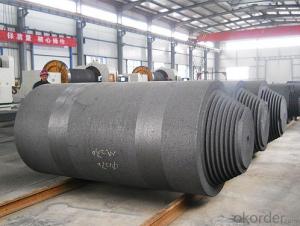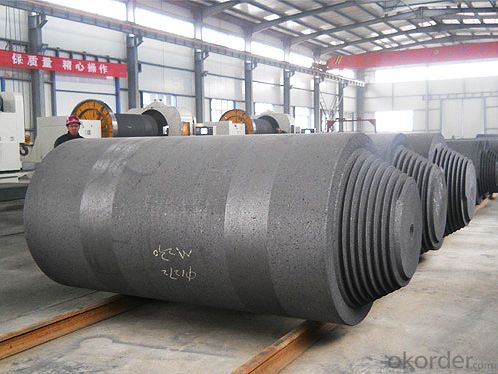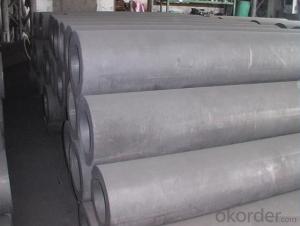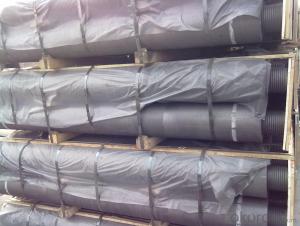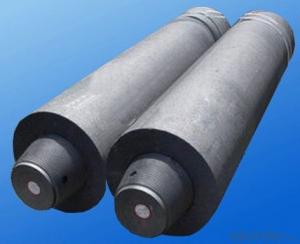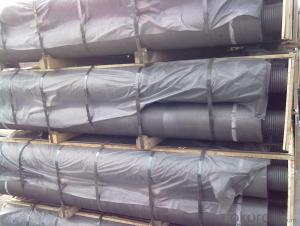Carbon Electrode With Φ500~Φ700 G Grade And Stable Quality
- Loading Port:
- Tianjin
- Payment Terms:
- TT or LC
- Min Order Qty:
- 20 m.t.
- Supply Capability:
- 800 m.t./month
OKorder Service Pledge
OKorder Financial Service
You Might Also Like
General Specification
PARAMETER UNIT GUARANTEE VALUE | ||||||
Ash.( % ) | 4.0 max | 5.0 max | 6.0 max | 7.0 max | 9.0 max | 11.0 max |
V.M (%) | 12.0-15.5 | 12.0-15.5 | 12.0-15.5 | 9.5-13.5 | 11.5-15.5 | 11.5-15.5 |
Compress Strength. (Mpa) | 18.0 min | 17 min | 15.7 min | 19.6 min | 19.6 min | 19.6 min |
Specific Resistance (μΩm) | 65 max | 68 max | 75 max | 80 max | 90 max | 90 max |
Bulk Density (G/CM3) | 1.38 min | 1.38 min | 1.38 min | 1.38 min | 1.38 min | 1.38 min |
Product Description
Carbon Electrode is abaked electrode used in submerged arc furnaces for delivering power to the charge mix. Electrode is added to the top of the electrode column cylindrical form. Electrode is essentially a mix of Electrically Calcined Anthracite (ECA) or Calcined Petroleum Coke (CPC) with Coal Tar Pitch and is baked for weeks, it is widly used for for ferroalloy,calcium carbide, silicon metal, production etc.
Picture
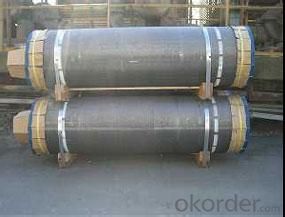
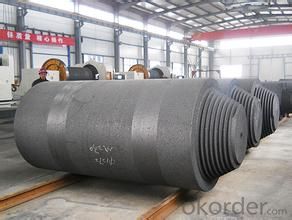
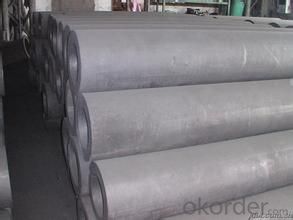
We Also supply all kind of carbon electrode paste and below materials, please contact us if you have any enquiry about it.
Calcined Anthracite
Calcined Petroleum Coke
Coke (Met Coke, Foundry Coke, Semi Coke)
- Q: What are the effects of carbon emissions on the stability of ice shelves?
- Carbon emissions have significant effects on the stability of ice shelves. As carbon dioxide (CO2) and other greenhouse gases are released into the atmosphere, they trap heat and contribute to global warming. This increased global temperature leads to the melting of ice shelves and glaciers. One of the primary effects of carbon emissions on ice shelves is the acceleration of their melting rates. Higher atmospheric temperatures cause more ice to melt, which in turn increases the amount of water flowing into the ocean. This added influx of freshwater can disrupt the delicate balance between the ice shelf and the ocean, potentially leading to ice shelf collapse. Additionally, carbon emissions contribute to the thinning of ice shelves. As the atmosphere warms, the air temperature above the ice shelves rises, leading to increased surface melting. This meltwater then flows into crevasses and cracks, causing further fracturing and weakening of the ice shelves. Over time, this thinning can make the ice shelves more susceptible to breaking apart. The melting of ice shelves due to carbon emissions also has indirect effects on the stability of surrounding ice sheets. Ice shelves act as a buttress, providing resistance to the flow of ice from the glaciers into the ocean. When ice shelves collapse or thin, this resistance is diminished, allowing glaciers to flow more freely into the ocean. This process leads to increased sea level rise, which has significant implications for coastal regions around the world. Furthermore, the loss of ice shelves can disrupt the ecosystem and biodiversity of the surrounding areas. Ice shelves provide a platform for various species, including seals and penguins, to breed and feed. When ice shelves disintegrate, these habitats are destroyed, impacting the entire food chain and ecosystem dynamics. Overall, carbon emissions from human activities have profound effects on the stability of ice shelves. The melting, thinning, and collapse of ice shelves contribute to rising sea levels, disrupt ecosystems, and have far-reaching consequences for coastal communities. It is crucial to mitigate carbon emissions and take proactive measures to protect these vulnerable ice shelves and the delicate balance they maintain in our global climate system.
- Q: What are the effects of ocean acidification on marine life?
- The detrimental effects of ocean acidification on marine life are substantial. The primary reason for this phenomenon is the rise in carbon dioxide (CO2) emissions, which the oceans absorb and cause a decrease in pH levels. This increasing acidity has profound consequences for a variety of marine organisms and ecosystems. Shell-forming organisms, such as corals, mollusks, and certain plankton, are among the most vulnerable groups affected by ocean acidification. The acidity reduces the availability of carbonate ions, which are crucial for these organisms to construct and upkeep their shells or skeletons. Consequently, their growth and development are hindered, making them more susceptible to predation and extinction. This not only impacts these specific species but also disrupts the entire food chain since they serve as a vital food source for numerous other marine organisms. Moreover, ocean acidification has negative effects on the physiology and behavior of various marine organisms. Research has indicated that it can impair the ability of fish to detect predators, find food, and navigate, leading to decreased survival rates and modified migratory patterns. Additionally, acidification can disrupt reproductive processes, such as the growth and survival of fish larvae, resulting in population declines and reduced biodiversity. Coral reefs, often referred to as the "rainforests of the sea," are especially susceptible to ocean acidification. The increased acidity hampers the calcification process necessary for coral growth, making them more prone to bleaching and death. As coral reefs provide essential habitats for numerous marine species, their decline would have a cascading impact on the entire ecosystem. Lastly, ocean acidification also affects the equilibrium of marine ecosystems by changing the composition and abundance of various species. Some organisms, like certain types of algae, may actually benefit from elevated CO2 levels and thrive, causing an imbalance in the ecosystem. This can result in the dominance of specific species, negatively impacting overall biodiversity and the stability of the marine environment. In conclusion, ocean acidification presents significant dangers to marine life. It disrupts the growth and development of shell-forming organisms, impairs the physiology and behavior of various marine species, damages coral reefs, and alters the composition of marine ecosystems. Addressing this issue is crucial to safeguard marine biodiversity, sustain fisheries, and maintain the overall health of our oceans.
- Q: How are carbon nanomaterials used in electronics?
- Carbon nanomaterials are widely used in electronics due to their unique properties and versatility. One of the most common applications of carbon nanomaterials in electronics is in the development of highly efficient and flexible conductive materials. Carbon nanotubes (CNTs) and graphene, both carbon nanomaterials, possess excellent electrical conductivity, making them ideal for creating conductive components in electronic devices. CNTs are cylindrical structures made of rolled-up graphene sheets. They can be used as interconnects in integrated circuits, improving their performance by reducing resistance and enhancing heat dissipation. Additionally, CNTs can be used in transistors, enabling faster and more efficient switching due to their high electron mobility. Their small size and flexibility make them suitable for creating transparent conductive films used in touchscreens and flexible electronics. Graphene, on the other hand, is a two-dimensional sheet of carbon atoms arranged in a hexagonal lattice. It is renowned for its exceptional electrical conductivity, high electron mobility, and excellent thermal conductivity. Graphene-based materials can be used as electrodes in batteries and supercapacitors, enhancing their energy storage capacity. Graphene transistors have the potential to replace traditional silicon-based transistors, allowing for faster and more energy-efficient electronic devices. Moreover, carbon nanomaterials, particularly CNTs, have shown promise in the field of nanoelectromechanical systems (NEMS). NEMS devices are incredibly small and sensitive, enabling applications such as sensors, actuators, and resonators. CNT-based NEMS devices have demonstrated exceptional sensitivity and responsiveness, making them suitable for various sensing applications, including pressure, gas, and biological sensing. In summary, carbon nanomaterials play a crucial role in electronics by providing highly conductive and versatile materials for various components and applications. Their unique properties, such as excellent electrical and thermal conductivity, make them ideal for creating faster, more efficient, and flexible electronic devices. As research and development in this field continue to progress, carbon nanomaterials are expected to revolutionize the electronics industry.
- Q: What are the impacts of carbon emissions on the spread of infectious diseases?
- The impacts of carbon emissions on the spread of infectious diseases are significant. Carbon emissions contribute to climate change, which in turn affects various factors that influence the spread of diseases. Rising temperatures, changes in precipitation patterns, and altered ecosystems all play a role in creating favorable conditions for the proliferation and transmission of infectious diseases. These changes can lead to the expansion of disease vectors like mosquitoes, ticks, and rodents, and increase the geographical range of diseases such as malaria, dengue fever, and Lyme disease. Additionally, carbon emissions can weaken human immune systems and exacerbate respiratory illnesses, making individuals more susceptible to infections. Overall, reducing carbon emissions is crucial to mitigate the impacts of climate change and curb the spread of infectious diseases.
- Q: How does carbon affect the formation of tsunamis?
- Carbon does not directly affect the formation of tsunamis. Tsunamis are typically caused by underwater earthquakes, volcanic eruptions, or landslides, which are not influenced by carbon. However, carbon emissions and climate change can indirectly impact the frequency and intensity of natural disasters, including some potential triggers for tsunamis, such as volcanic activity or landslides near coastlines.
- Q: What are the impacts of carbon emissions on the stability of deserts?
- Carbon emissions have significant impacts on the stability of deserts. One of the key consequences is the exacerbation of desertification, which refers to the process of fertile land turning into desert due to various factors, including climate change. Carbon emissions contribute to global warming, leading to higher temperatures and increased evaporation rates, which in turn result in reduced soil moisture and increased aridity in desert regions. This intensifies the process of desertification, causing deserts to expand and become more unstable. Furthermore, carbon emissions contribute to the alteration of precipitation patterns, which directly affects the stability of deserts. As climate change leads to shifts in weather patterns, some areas may experience reduced rainfall, while others may face more frequent and intense droughts. These changes in precipitation can further exacerbate desertification processes and lead to increased desert instability. Another impact of carbon emissions on desert stability is the increased frequency and intensity of dust storms. As global warming leads to drier conditions and reduced vegetation cover, the risk of dust storms becomes higher. These storms can transport vast amounts of fine particulate matter, including dust and sand, over long distances, resulting in a range of negative consequences. Dust storms can damage infrastructure, harm human health, degrade air quality, and further contribute to desertification processes by removing fertile topsoil. Additionally, the impacts of carbon emissions on deserts are not limited to their ecological stability but also have socio-economic implications. Many communities in desert regions rely on agriculture and natural resources for their livelihoods. The destabilization of deserts due to carbon emissions can lead to reduced agricultural productivity, increased food insecurity, and economic hardship for these communities. Moreover, the displacement of people from desert regions due to desertification can lead to increased migration and social instability. In conclusion, carbon emissions have far-reaching impacts on the stability of deserts. They contribute to the intensification of desertification processes, alter precipitation patterns, increase the frequency and intensity of dust storms, and have socio-economic consequences. Addressing carbon emissions through climate change mitigation strategies is crucial to minimize these impacts and ensure the long-term stability of desert ecosystems and the communities that depend on them.
- Q: How do you remove car carbon?
- 3, running high speed can flush carbon deposition? Running high speed, you can really use the airflow on the airway erosion, wash away part of the carbon deposition. So, if you happen to go out, there are high-speed, national road two choices, you may choose to pull back to speed. But, Ma director thinks, if be in order to "flush carbon deposit" specially, want to run high speed, do not have this necessity. "It is a waste of time, and the cost of oil, extra high speed tolls, the effect is better to do a maintenance 4S shop!" 4, improve the shift speed, such as the original speed 2000rpm shift, modified 2500rpm conversion, generated can prevent carbon deposition, but also to protect the engine? Ma director said, low speed the shift, is often said that the "drag block", the car is easy to knock, the combustion of gasoline is not sufficient to carbon deposition. But it's not necessary for people to increase gear speed - that will increase fuel consumption and cause premature wear of clutch friction plates. So, manual transmission of the car, 1.6 ~ 2.0L displacement, about 2000 rpm shift is more economical, and no need to improve; and automatic car, pay attention not to slam the gas.
- Q: How does carbon monoxide affect human health?
- Human health can be severely impacted by carbon monoxide, a highly toxic gas. When we breathe it in, carbon monoxide enters our bloodstream and binds with hemoglobin, the molecule responsible for delivering oxygen to our cells. This binding is incredibly strong and hampers the effective delivery of oxygen, resulting in a condition known as carboxyhemoglobinemia. The symptoms of carbon monoxide poisoning can vary depending on the concentration and duration of exposure. Initially, individuals may experience mild symptoms like headaches, fatigue, dizziness, and nausea. However, if exposure continues or occurs at higher concentrations, these symptoms can escalate to confusion, impaired judgment, loss of consciousness, and even death. One of the most dangerous aspects of carbon monoxide is its ability to go unnoticed, as it lacks color, odor, and taste. This makes it difficult to detect its presence without proper monitoring equipment. Carbon monoxide poisoning can arise from various sources, including faulty heating systems, poorly ventilated appliances, and running engines in enclosed spaces. Prolonged or repeated exposure to carbon monoxide can result in long-term health consequences. It can lead to neurological damage, memory loss, cognitive impairment, and even permanent brain damage. Additionally, it can worsen existing cardiovascular conditions, increasing the chances of heart attacks and strokes. To safeguard ourselves from carbon monoxide poisoning, it is crucial to ensure proper ventilation and functional carbon monoxide detectors in our homes and workplaces. Regular maintenance of appliances and heating systems is also essential to minimize the risk of leaks. Recognizing the symptoms of carbon monoxide poisoning and seeking immediate medical attention are vital in preventing severe health outcomes.
- Q: What is carbon fiber and how is it used?
- Carbon fiber is a lightweight and strong material composed of thin strands of carbon atoms. It is used in various industries, including aerospace, automotive, and sports equipment manufacturing. It is commonly used to make components that require high strength and low weight, such as aircraft wings, car bodies, bicycle frames, and tennis rackets. Its excellent mechanical properties, including high tensile strength and stiffness, make it an ideal choice for applications where strength and weight reduction are crucial.
- Q: What is the structure of graphite, another form of carbon?
- Graphite has a layered structure where carbon atoms are arranged in hexagonal rings, forming sheets of interconnected hexagons. These sheets are stacked on top of each other, with weak forces of attraction between them, resulting in a slippery and flaky structure.
Send your message to us
Carbon Electrode With Φ500~Φ700 G Grade And Stable Quality
- Loading Port:
- Tianjin
- Payment Terms:
- TT or LC
- Min Order Qty:
- 20 m.t.
- Supply Capability:
- 800 m.t./month
OKorder Service Pledge
OKorder Financial Service
Similar products
Hot products
Hot Searches
